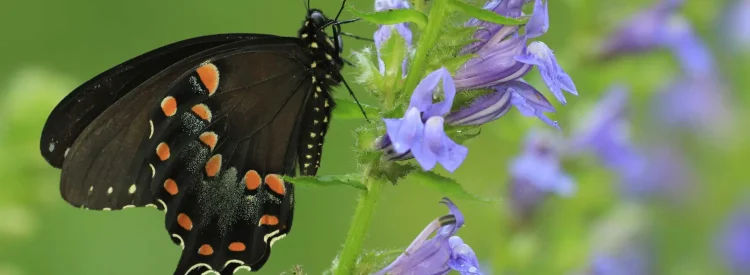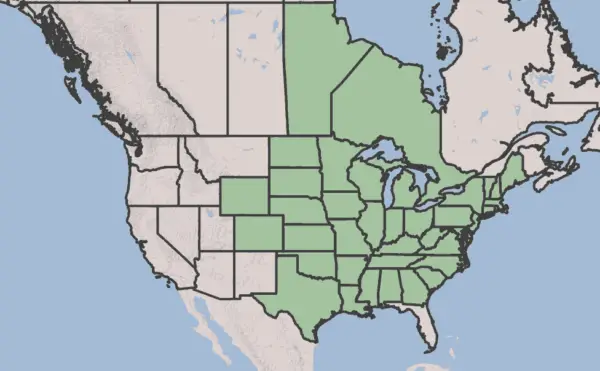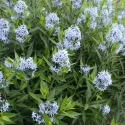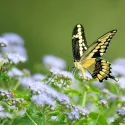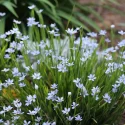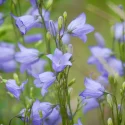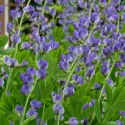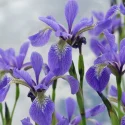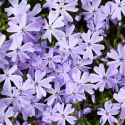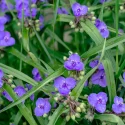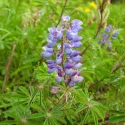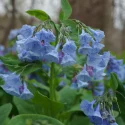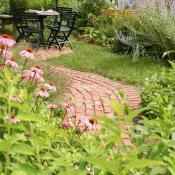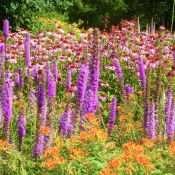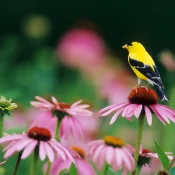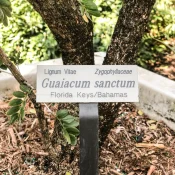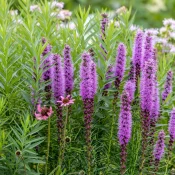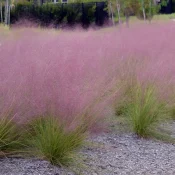This tall, stately native flower stands with a light saber of blue flowers in the summer. Butterflies and hummingbirds both love this plant. Great Blue Lobelia is easy to plant from seed; seeds planted in the spring will flower later in the summer. They love wetter areas, making them perfect for rain gardens or areas that collect water after it rains. Read on for growing tips!
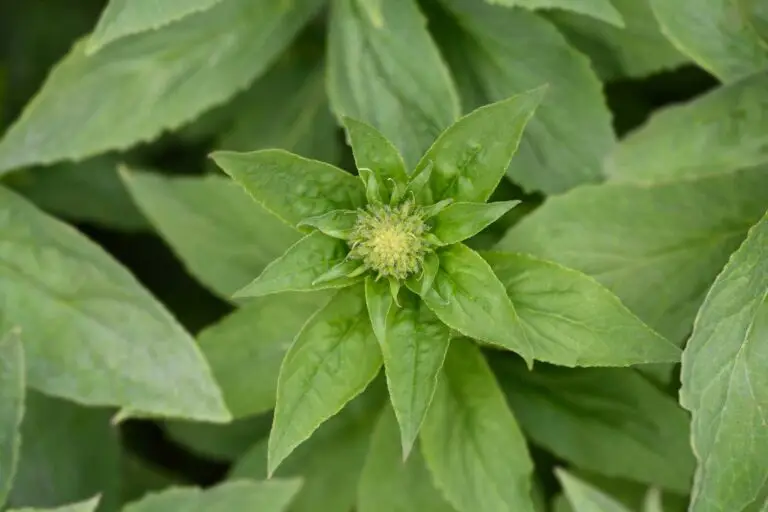
Is Great Blue Lobelia deer-proof?
Sadly, according to the USDA, deer love to snack on Great Blue Lobelia. If you’re worried about deer in your garden, this might not be the best plant to grow.
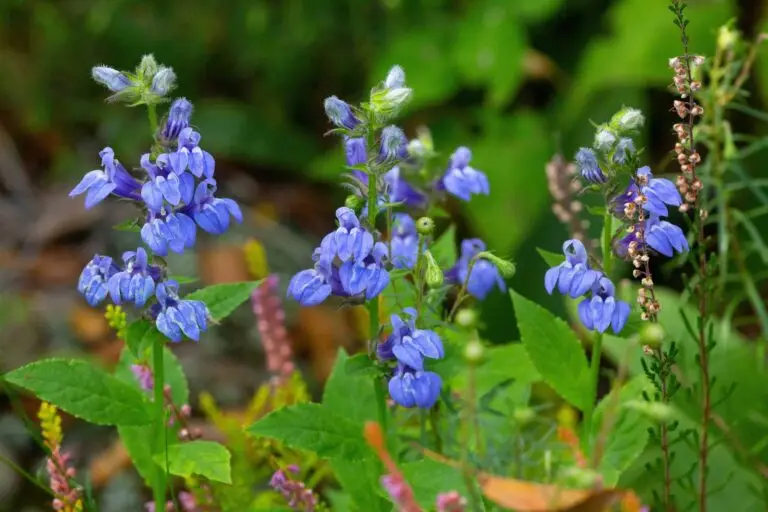
Great Blue Lobelia likes water
Great Blue Lobelia loves to live in wet areas. Rain gardens, areas where water frequently pools, or even nearby gutter downspouts are all great places to plant Great Blue Lobelia.
Where is Great Blue Lobelia native?
Great Blue Lobelia is native to a huge part of the United States and Canada. Unless you live in the westernmost part of North America, you can easily grow this flower.
How to grow Great Blue Lobelia
Great Blue Lobelia is exceptionally easy to grow from seed. Most of the time, Great Blue Lobelia will flower the first year it’s planted from seed.
Grow a patch of Great Blue Lobelia from seed
If you have the space, Great Blue Lobelias shine when planted in groups. To plant Great Blue Lobelia from a friend or neighbor’s garden…
- In the fall, grab one of the tall stalks when the flowers have turned to seed
- In your garden, lay the stalk down—stem and all—in the fall/winter
- Cover very lightly with soil (Great Blue Lobelias need sunlight to grow, so don’t plant them too deep!)
- In the spring you’ll see the tiny seedlings emerge
- Planting the entire stalk ensures you’ll have a small patch of Great Blue Lobelias
- Make sure they stay consistently moist as they grow
Grow individual Great Blue Lobelia from seed
- Grab a Great Blue Lobelia stalk in the fall from a friend or neighbor’s garden
- Put the entire stalk inside a Ziplock bag and shake to separate all the flower bits
- If the seed capsules are still intact, roll a rolling pin over them to help break them open
- Dump the contents out onto a sheet of parchment paper and separate the tiny black seeds from the stem and capsule bits
- Plant seeds individually in pots or directly in your garden under a light sprinkling of soil
- Make sure they stay consistently moist as they grow
Where to buy Great Blue Lobelia seed and plants
There are many reputable places to buy Great Blue Lobelia plants and seeds online, including:
- Prarie Moon Nursery ($3 for a packet of seeds / $7 for a bare root plant)
- Monticello—yes, that Monticello, Thomas Jefferson’s house! ($3.95 for a packet of seeds)
- Seed Nerds ($1.99 for 100 seeds)
As you buy plants and seed, we have a tip:
Plants and seeds grown close to home are tuned to your soil, weather, and pollinators. Stay within 500 miles—or about a day’s drive—to help your garden thrive naturally.
Here are four ideas to find these native gems in your area:
Where can I find seeds and plants?
Finding native plants can be challenging (we partly blame Marie Antoinette.) To make it easier, we’ve assembled four sourcing ideas.
300+ native nurseries make finding one a breeze
Explore 100+ native-friendly eCommerce sites
Every state and province has a native plant society; find yours
Online Communities
Local Facebook groups are a great plant source
How to keep Great Blue Lobelias from self-seeding in your garden
Because it’s so easy to plant these from seed, they easily replant themselves in gardens. A plant that easily self-seeds and multiplies in gardens is often labeled as ‘aggressive.’ Some gardeners call Great Blue Lobelia aggressive, but it’s easy to keep them in check.
To keep Great Blue Lobelia plants from spreading, simply cut down the stalks in the fall and give them away to your neighbors and friends. That’s it! This will help cut down the amount of seed that spreads in your landscape.
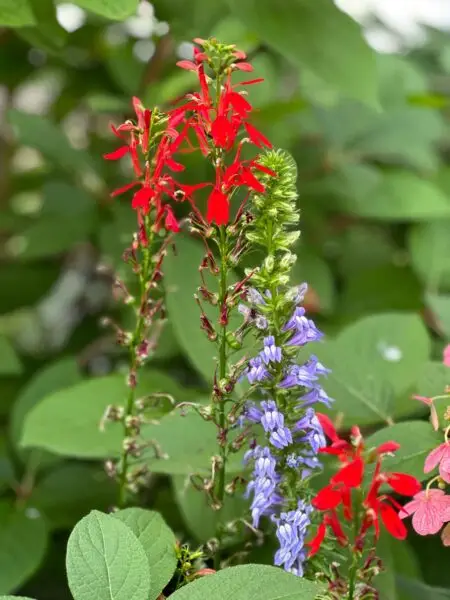
Great Blue Lobelia has a red cousin: Cardinal Flower
If you’d like to put on a tall, stately flower show in the summer, consider planting some Cardinal Flower alongside your Great Blue Lobelia. Cardinal Flower is known as a particular hummingbird favorite.
Both are in the Lobelia family, and you’ll see from a quick glance how similar their shape and flowers are.
Great Blue Lobelia is a beautiful native flower that attracts both butterflies and hummingbirds to gardens. Its natural blue color is rare in gardens, so it stands apart from other plants. It’s exceptionally easy to plant from seed and will flower the same year it’s planted. Plant them in groups to help them shine. They are a beautiful addition to any Mid-Atlantic, Midwest, Northeast, or Southern garden. Happy planting!
Sources
- Nelson, Gil. Best Native Plants for Southern Gardens: A Handbook for Gardeners, Homeowners, and Professionals, (2010).
- Harstad, Carolyn. Go Native! Gardening with Native Plants and Wildflowers in the Lower Midwest. (1999), 209-210.
- USDA’s Plant Guide: Great Blue Lobelia (PDF).
What if your feed was actually good for your mental health?
Give your algorithm a breath of fresh air and follow us.
